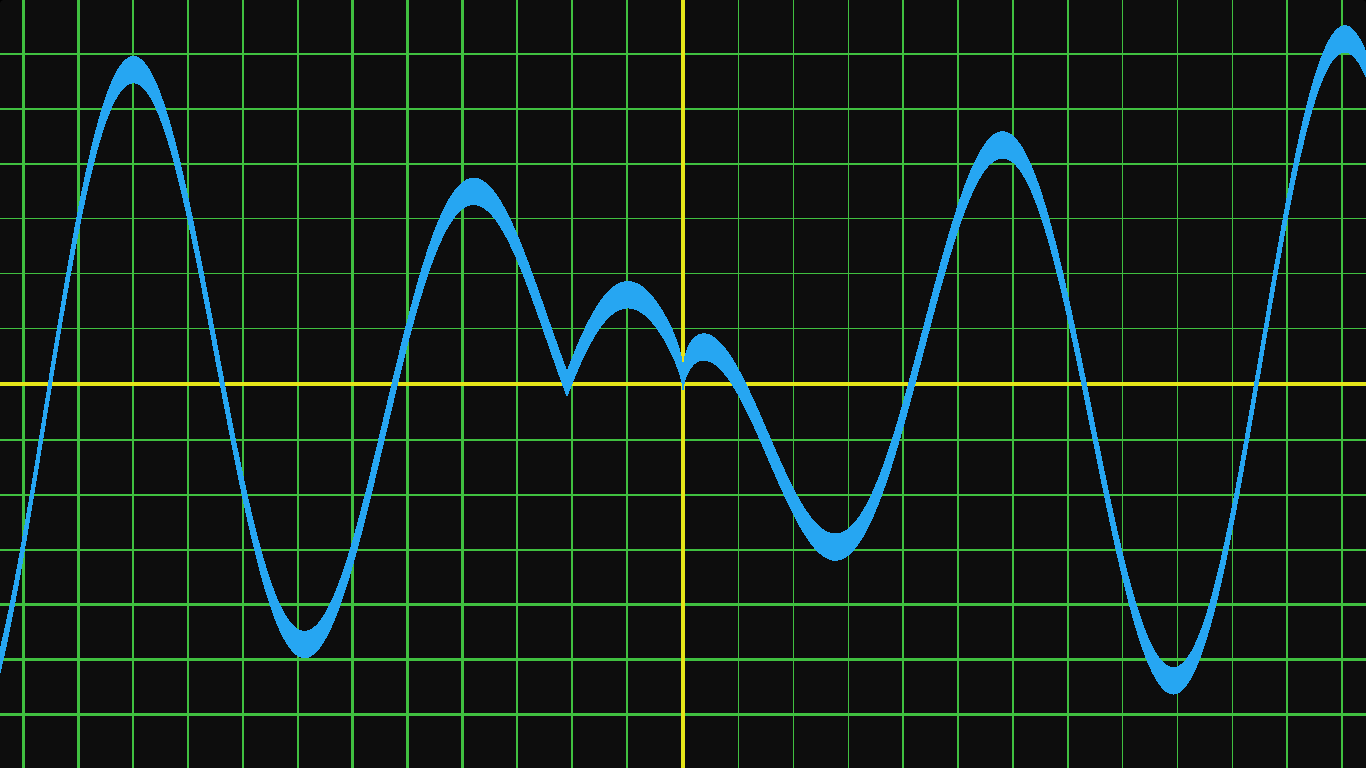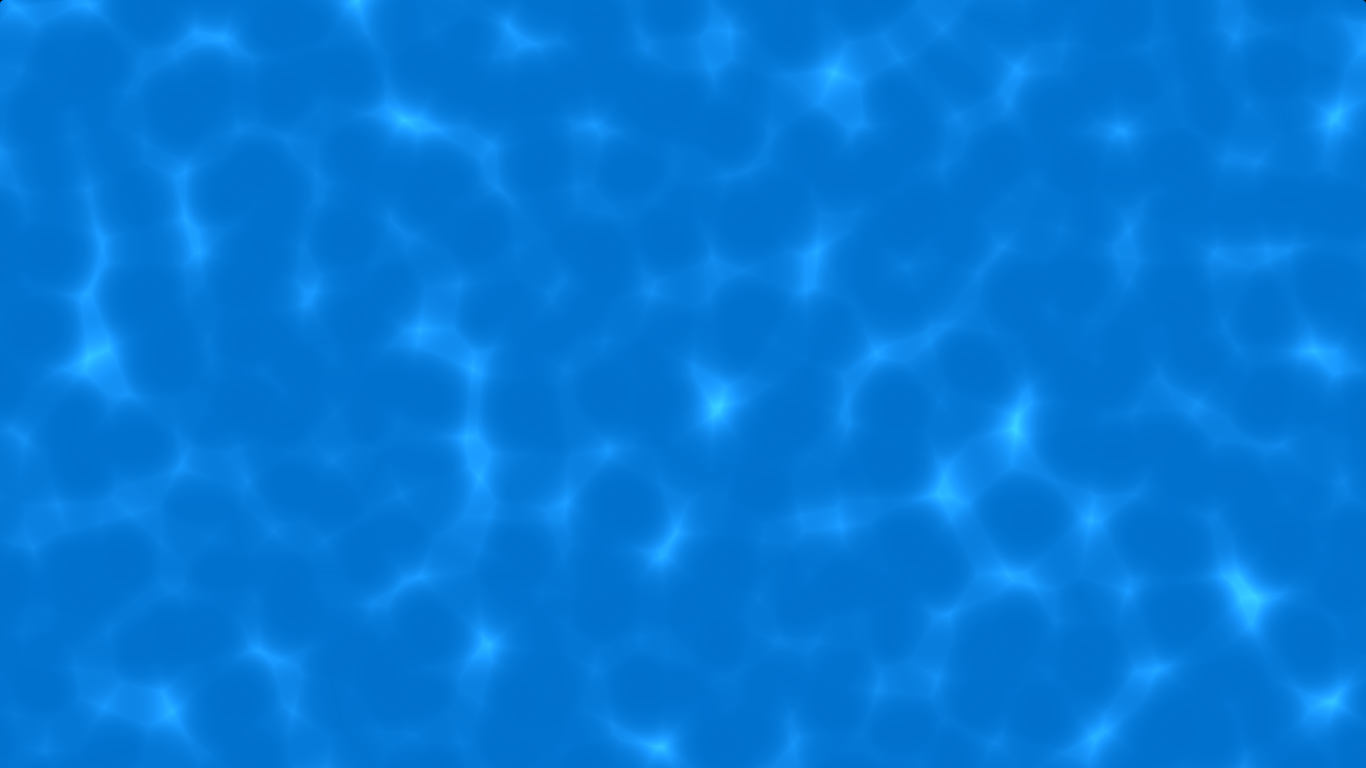This is a library of pixel shaders written on ShaderToy, with most shaders based on concepts of procedural generation.
Pixel shaders run for every single pixel on the screen. For each pixel, we will have the pixel position as the input. Pixel position is in the format (X, Y), ranging from (0, 0) [bottom left] to (MaxX, MaxY) [top right].
The pixel code will output a value that determines the color of that pixel. The combined output for all the pixels will give us the image. By using the time variable, we can create shaders that loop or change over time.
Example shaders implemented in ShaderToy:

// graph_2d.fs
void mainImage(out vec4 fragColor, in vec2 fragCoord)
{
// 1. Setup Data
// Gets the Y limit for square grid
float xLimit = (yLimit + 1.0f) * (iResolution.x / iResolution.y) - 1.0f;
// From (0 to 1)
vec2 uv = fragCoord / iResolution.xy;
// From (-1 to 1)
vec2 pos = (uv * 2.0f) - 1.0f;
// From (-X to X, -Y to Y)
pos.x *= (xLimit + 1.0f);
pos.y *= (yLimit + 1.0f);
// 2. Setup Color
// a. Default Color is the Background
vec3 col = bgColor;
// b. If the point lies on the grid lines, then change color
if(check_point(pos.x, xLimit , iResolution.x) || check_point(pos.y, yLimit, iResolution.y))
{
col = gridColor;
if((check_point(pos.x, xLimit , iResolution.x) && get_int(pos.x) == 0.0f) ||
(check_point(pos.y, yLimit , iResolution.y) && get_int(pos.y) == 0.0f))
{
col = axesColor;
}
}
// c. If the point satisfies the Equation, then change color
if(check_equation(pos))
{
col = eqColor;
}
// 3. Output to screen
fragColor = vec4(col,1.0);
}

// wood_shader.fs
void mainImage( out vec4 fragColor, in vec2 fragCoord )
{
vec2 uv=fragCoord/iResolution.xy;
uv=uv*2.0f-1.0f;
uv.x*=(iResolution.x/iResolution.y);
uv*=xScale*yScale;
float fac=4.0f;
float freq=1.5f;
float t=get_octave_noise(freq*uv/(xScale*yScale));
float p = sqrt(pow(uv.x*xScale,2.0f)+pow(uv.y*yScale,2.0f));
p += t*fac;
float h = sin(p);
h=h*h;
h=1.0f-h;
h+=0.2f;
h=pow(h,2.0f);
h=smoothstep(h,-1.0f,-0.2f);
vec3 col=mix(baseCol,detailCol*h,h);
// Output to screen
fragColor = vec4(col,1.0);
}

// water_shader.fs
void mainImage( out vec4 fragColor, in vec2 fragCoord )
{
// Gets UVs
vec2 uv=fragCoord/iResolution.y;
uv*=float(GRID_HEIGHT);
// Gets **Offset**
vec2 offset=vec2(0.0f);
offset.y=-iTime*3.0f;
offset.x=cos(iTime*0.5f)*2.0f;
// Get Height Map
float h=get_voronoi_noise(uv+offset);
h=clamp(h,0.0f,1.0f);
h=pow(h,p);
// Final Color
vec3 col=vec3(h)*highlightCol+waterCol;
// Output to screen
fragColor = vec4(col,1.0);
}

// fire_shader.fs
vec3 get_color(vec2 pos)
{
darkCol=vec3(0.0f,0.05f,0.1f);
lightCol=vec3(0.0f,0.85f,0.15f);
// Get Octave Height
float hF = get_octave_noise(pos*lF.x,lF.y,lF.z);
float hB = get_octave_noise(pos*lB.x,lB.y,lB.z);
hF=pow(hF,1.25f)*1.1f;
hB*=0.75f;
// Get Fractal Height
float fF=get_fractal_height(pos*lF.x,lF.y,lF.z);
float fB=get_fractal_height(pos*lB.x,lB.y,lB.z);
// Apply Limits
vec4 limF=limitsF;
if(pos.x<limF.x || pos.x>limF.y || pos.y<limF.z || pos.y > limF.w)
{
hF=0.0f;
}
vec4 limB=limitsB;
if(pos.x<limB.x || pos.x>limB.y || pos.y<limB.z || pos.y > limB.w)
{
hB=0.0f;
}
// Apply Alpha Limits
float h1=distance(pos,cF.xy)/cF.z;
h1=clamp(h1,0.0f,1.0f);
h1=1.0f-h1;
hF*=h1*1.5f;
float h2=distance(pos,cB.xy)/cB.z;
h2=clamp(h2,0.0f,1.0f);
h2=1.0f-h2;
hB*=h2*1.75f;
// Apply Fractal
hF*=fF;
hF=smoothstep(0.0f,0.35f,hF);
hB*=fB;
hB=smoothstep(0.0f,0.35f,hB);
// Apply Threshold
if(hF<0.25f)
{
hF=0.0f;
}
if(hB<0.05f)
{
hB=0.0f;
}
// Apply Color
vec3 col=mix(darkCol, vec3(0.0f),pos.y-0.2f*sin(1.25f*iTime));
if(hB>0.0f)
{
col=mix(darkCol,mix(darkCol,lightCol,0.5f),hB*1.25f);
if(hB<=0.06f)
{
col=vec3(0.25f*darkCol);
}
}
if(hF>0.0f)
{
col=mix(darkCol,lightCol,hF);
if(hF<=0.28f)
{
col=vec3(0.5f*darkCol);
}
}
return col;
}

// map_2d.fs
vec3 get_color(vec2 uv)
{
bool insideMap=true;
float timeFac=0.85f;
vec3 shadowMap=vec3(1.0f);
bool applyShadow=false;
// Get Height
float h= NOISE_FUNCTION(uv,timeFac);
vec3 col=vec3(h);
#if ENABLE_LIGHT
vec2 lightDir=vec2(1.0f,0.0f);
float theta=float(LIGHT_ANGLE + iTime*45.0f)*(3.1416f/180.0f);
mat2 rot=mat2(cos(theta), -sin(theta),
sin(theta), cos(theta));
lightDir=normalize(lightDir*rot);
float checkDist=float(LIGHT_CHECK);
float hP=NOISE_FUNCTION(uv-lightDir*checkDist,timeFac);
float xDiff=checkDist;
float yDiff=(hP-h);
float delH=tan(LIGHT_ELEVATION_ANGLE*(3.1416f/180.0f))*xDiff;
if(insideMap)
{
if(yDiff<delH)
{
yDiff=0.0f;
}
yDiff=1.0f-yDiff;
if(yDiff>=0.0f)
{
yDiff=pow(yDiff,LIGHT_INTENSITY);
}
shadowMap=vec3(yDiff);
}
#endif
#if APPLY_FALLOFF
// Apply Falloff
float diff = falloff(uv,0.0f);
if(h-diff<0.0f)
{
insideMap=false;
}
h = clamp(h-diff, 0.0f, 1.0f);
col=vec3(h);
#endif
#if COLOR_MAP
// Get Color from Region
int index = get_region_index(h);
col = regions[index];
#endif
// Blend Region Colors
#if BLEND_REGIONS
float h2 = ((index+1)<8?heights[index+1]:1.0f);
float off = linear_step(heights[index],h2,h);
//off=smoothstep(heights[index],h2,h);
if(off>=MIX_THRESHOLD/2.0f)
{
applyShadow=true;
}
if(off>=MIX_THRESHOLD)
{
col = mix(col, mix(col, regions[index+1], off), MIX_FACTOR);
}
#endif
// Apply Cloud Cover
#if DRAW_CLOUDS
if(insideMap)
{
float cH=cloud_map(uv);
vec3 cloud = vec3(cH);
if(cH>0.0f)
{
col = (cloud*CLOUD_BLEND)+col*(1.0f-CLOUD_BLEND);
}
}
#endif
if(insideMap && index>2 && applyShadow)
{
col*=shadowMap;
}
return col;
}